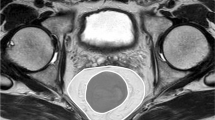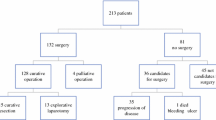Abstract
Background and aims
Although the standard of care for T3 and/or N1–2 rectal cancers includes adjuvant chemoradiation, it is unclear whether T3 N0 patients with limited microscopic perirectal fat invasion warrant further therapy. Our aim was to determine the prognostic significance of gross perirectal fat invasion, or depth of microscopic perirectal fat invasion, in T3 N0 rectal cancers following sharp mesorectal excision and no adjuvant therapy.
Patients and methods
Utilizing a prospective database, the medical records of 108 patients who underwent a potentially curative resection for T3 N0 rectal cancer between June 1986 and December 1994 were analyzed. All pathological specimens were re-reviewed by a single pathologist, and extent of perirectal fat invasion was measured in millimeters. Patients who received either preoperative or postoperative adjuvant therapy were excluded.
Results
Macroscopic perirectal fat invasion (T3 gross) was present in 49 cases, absent in 40 cases (T3 microscopic), and not reported in 19 cases. Rectal cancers were stratified by extent of measured perirectal fat invasion into 3 mm or less and more than 3 mm. Five-year overall and local recurrence rates for the entire group were 19% and 8%, respectively. The disease-free survival, disease-specific survival, and overall recurrence for rectal cancers with 3 mm or less invasion vs. more than 3 mm invasion, or T3 gross vs. T3 microscopic, were not statistically different.
Conclusion
Our data suggest that the extent of gross, or microscopic perirectal fat invasion (defined as >3 or ≤3 mm), determined in the resected specimen, does not predict outcome in select T3 N0 rectal cancers.



Similar content being viewed by others
References
National Institutes of Health Consensus Conference (1990) Adjuvant therapy for patients with colon and rectal cancer. JAMA 264:1444–1450
Gastrointestinal Tumor Study Group (1985) Prolongation of the disease-free interval in surgically treated rectal carcinoma. N Engl J Med 312:1465–1472
Krook JE, Moertel CG, Gunderson LL, et al (1991) Effective surgical adjuvant therapy for high-risk rectal carcinoma. N Engl J Med 324:709–715
O'Connell MJ, Martenson JA, Wieand HS, et al (1994) Improving adjuvant therapy for rectal cancer by combining protracted-infusion fluorouracil with radiation therapy after curative surgery. N Engl J Med 331:502–507
Tepper JE, O'Connell MJ, Petroni GR, et al (1997) Adjuvant postoperative fluorouracil-modulated chemotherapy combined with pelvic radiation therapy for rectal cancer: initial results of intergroup 0114. J Clin Oncol 15:2030–2039
Vigliotti A, Rich TA, Romsdahl MM, Withers HR, Oswald MJ (1987) Postoperative adjuvant radiotherapy for adenocarcinoma of the rectum and rectosigmoid. Int J Radiat Oncol Biol Phys 13:999–1006
Kollmorgen CF, Meagher AP, Wolff BG, Pemberton JH, Martenson JA, Illstrup DM (1994) The long-term effect of adjuvant postoperative chemoradiotherapy for rectal carcinoma on bowel function. Ann Surg 220:676–682
Paty PB, Enker WE, Cohen AM, Minsky BD, Friedlander-Klar H (1994) Long-term functional results of coloanal anastomosis for rectal cancer. Am J Surg 167:90–94
Tepper JE, Cohen AM, Wood WC, Orlow EL, Hedberg SE (1987) Postoperative radiation therapy of rectal cancer. Int J Radiat Oncol Biol Phys 13:5–10
Heald RJ, Moran BJ, Ryall RD, Sexton R, MacFarlane JK (1998) Rectal cancer: the Basingstoke experience of total mesorectal excision, 1978–1997. Arch Surg 133:894–899
Enker WE, Thaler HT, Cranor ML, Polyak T (1995) Total mesorectal excision in the operative treatment of carcinoma of the rectum. J Am Coll Surg 181:335–346
Arbman G, Nilsson E, Hallbook O, Sjodahl R (1996) Local recurrence following total mesorectal excision for rectal cancer. Br J Surg 83:375–379
Willett CG, Badizadegan K, Ancukiewicz M, Shellito PC (1999) Prognostic factors in stage T3/N0 rectal cancer: do all patients require postoperative pelvic irradiation and chemotherapy? Dis Colon Rectum 42:167–173
Merchant NB, Guillem JG, Paty PB, et al (1999) T3/N0 rectal cancer: results following sharp mesorectal excision and no adjuvant therapy. J Gastrointest Surg 3:642–647
Cawthorn SJ, Parums DV, Gibbs NM, et al (1990) Extent of mesorectal spread and involvement of lateral resection margin as prognostic factors after surgery for rectal cancer. Lancet 335:1055–1059
Merkel S, Mansmann U, Siassi M, Papadopoulos T, Hohenberger W, Hermanek P (2001) The prognostic inhomogeneity in pT3 rectal carcinomas. Int J Colorectal Dis 16:298–304
Minsky BD, Mies C, Recht A, Rich TA, Chaffey JT (1988) Resectable adenocarcinoma of the rectosigmoid and rectum. I. Patterns of failure and survival. Cancer 61:1408–1416
Jass JR, Love SB, Northover JM (1987) A new prognostic classification of rectal cancer. Lancet I:1303–1306
Williams NS, Jass JR, Hardcastle JD (1988) Clinicopathological assessment and staging of colorectal cancer. Br J Surg 75:649–652
Adam IJ, Mohamdee MO, Martin IG, et al (1994) Role of circumferential margin involvement in the local recurrence of rectal cancer. Lancet 344:707–711
Quirke P, Durdey P, Dixon MF, Williams NS (1986) Local recurrence of rectal adenocarcinoma due to inadequate surgical resection. Histopathological study of lateral tumour spread and surgical excision. Lancet II:996–999
Birbeck KF, Macklin CP, Tiffin NJ, et al (2002) Rates of circumferential resection margin involvement vary between surgeons and predict outcomes in rectal cancer surgery. Ann Surg 235:449–457
Nagtegaal ID, Marijnen CA, Kranenbarg EK, van de Velde CJ, van Krieken JH (2002) Circumferential margin involvement is still an important predictor of local recurrence in rectal carcinoma: not one millimeter but two millimeters is the limit. Am J Surg Pathol 26:350–357
Hall NR, Finan PJ, al-Jaberi T, et al (1998) Circumferential margin involvement after mesorectal excision of rectal cancer with curative intent. Predictor of survival but not local recurrence? Dis Colon Rectum 41:979–983
Wolmark N, Wieand HS, Hyams DM, et al (2000) Randomized trial of postoperative adjuvant chemotherapy with or without radiotherapy for carcinoma of the rectum: National Surgical Adjuvant Breast and Bowel Project Protocol R-02. J Natl Cancer Inst 92:388–396
Kapiteijn E, Marijnen CA, Nagtegaal ID, et al (2001) Preoperative radiotherapy combined with total mesorectal excision for resectable rectal cancer. N Engl J Med 345:638–646
Acknowledgements
This research was presented in part at the 37th Annual Meeting of the American Society of Clinical Oncology, 12 May 2001 in San Francisco, Calif., USA.
Author information
Authors and Affiliations
Corresponding author
Additional information
An invited commentary on this paper is available at http://dx.doi.org/10.1007/s00384-003-0505-0
Rights and permissions
About this article
Cite this article
Picon, A.I., Moore, H.G., Sternberg, S.S. et al. Prognostic significance of depth of gross or microscopic perirectal fat invasion in T3 N0 M0 rectal cancers following sharp mesorectal excision and no adjuvant therapy. Int J Colorectal Dis 18, 487–492 (2003). https://doi.org/10.1007/s00384-003-0504-1
Accepted:
Published:
Issue Date:
DOI: https://doi.org/10.1007/s00384-003-0504-1




